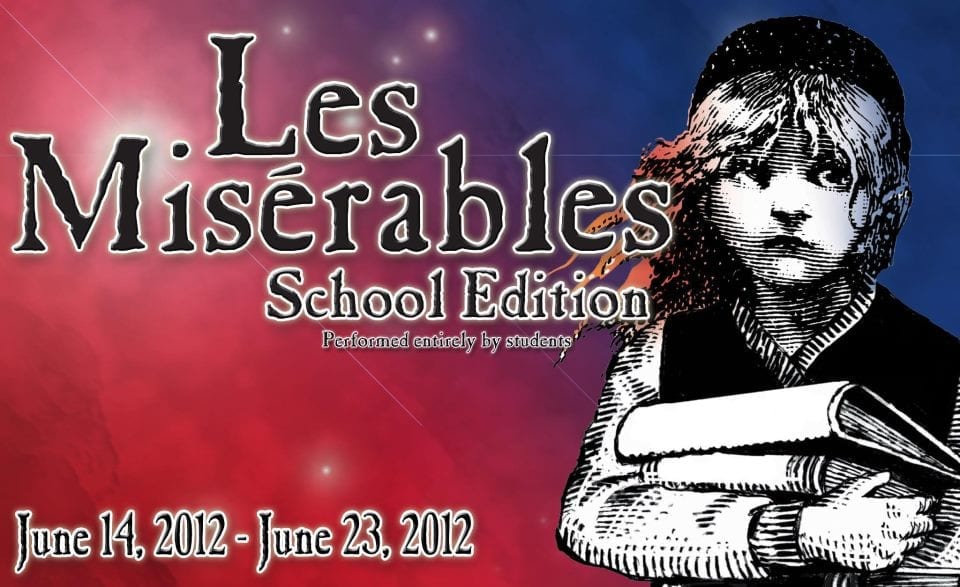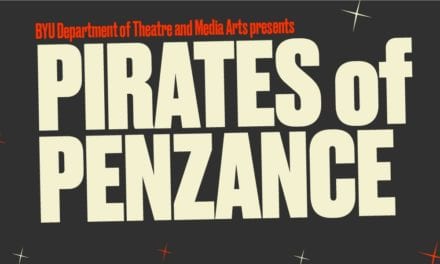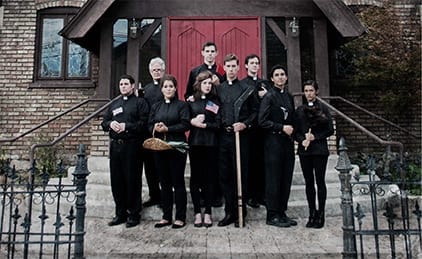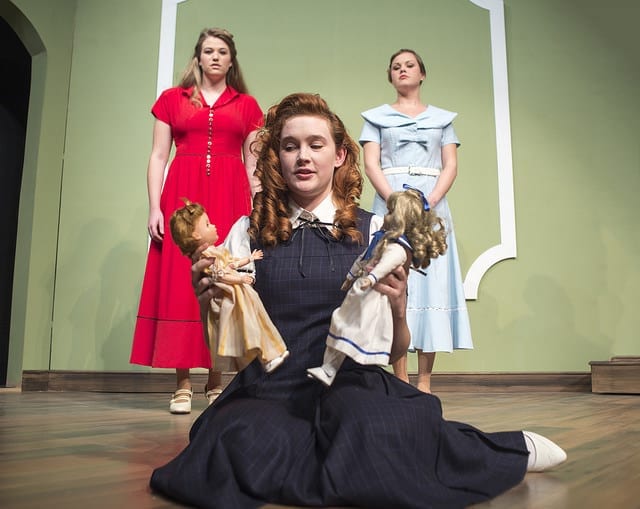RIVERTON — Following the journey of ex-convict Jean Valjean as he spends nineteen years making moral amends and evading his parole, Les Misérables is a tale of humanity set against the backdrop of a French uprising. Wary of this abridged “school edition,” I attended Riverton Arts Council’s youth production expecting to be served Les Misérables Lite. Instead, I got every bit of “shame, anger, sadness, hopelessness, pleasure, courage, and hope” which director Kim Ostler stated in her program notes she was hoping to display on the stage. Although the show was performed entirely by students, they handled the adult themes expertly, owning up to the emotions which incited the darker language and themes of the plot.
The production started with a boat full of convicts, rowing under the direction of Inspector Javert (Connor Wade). The unison clanking of the oars in time to the opening strains of “Look Down” infused the number with intensity and immediately heightened my expectations for the performance. I was not disappointed when the cast again took the stage and began “At the End of the Day.” It was clear that musical director Lisa Lefler Olsen had done her job well. Not only were the harmonies full and balanced, but this song and subsequent production numbers were delivered with dynamic intensity.
Several actors and actresses delivered near-flawless performances including Garrett A. Danielson as Valjean. Danielson handled the huge vocal range of Valjean as expertly as he delivered Valjean’s varied emotions. Emma Driggs portrayal of Fantine was nothing short of captivating. Somehow, Driggs evoked more story with her eyes than many veteran actresses manage with their entire bodies. Josh Call’s spunk and adorably accurate accent as Gavroche provided a bit of relief and contrast to the consistently dark themes of the show. While I raved about these characters on the drive home, my husband hailed Wade as his favorite vocalist of the evening, and we both agreed that “Javert’s Suicide” may have been the vocal highlight of the production.
Carlie Young‘s portrayal of Eponine was deeply moving, although she occasionally lacked power in her vocals. “On My Own” began beautifully, but unfortunately did not seem to gain any intensity as she progressed. However, “A Little Fall of Rain” was perfectly suited for her vocal style and the softer dynamics highlighted the smooth texture of her voice. Another character which fell just short of my expectations was Connor Healy as Marius. Healy’s melodies and rhythms were accurate, but he was sometimes difficult to understand.
This edition of Les Misérables included many opportunities for ensemble members to sing short solos. While many soloists maintained the high quality of vocal performance, several others seemed hesitant on the rhythms or were weak on the melodies. Sharing these solo opportunities throughout the ensemble exposed a few weaknesses in the cast, but I think that it was worth it in order to give these young performers more opportunities to have their moment in the spotlight and gain experience.
Perhaps one of the most impressive elements of this production was the consistent acting. As I scanned the stage during “At the End of the Day,” I saw the 30+ people on the stage each portraying a character. If ever there was a moment where an individual onstage was not fully invested in his or her own story, it did not come to my attention. As a result, each story was believable. Instead of feeling like I was watching a retelling of a story, I was seeing the story unfold authentically for the first time.
Adding to that authenticity, the set, costumes, and technical aspects worked together almost seamlessly in such a way that, despite their beauty, I almost didn’t notice them. The set, created by Mark Halvorsen, utilized a few moving elements in front of a static French backdrop. The consistency of the main set allowed for scene changes that were smooth and unobtrusive. An image displaying the scene’s city and year was projected above the proscenium; the projections were noticeable without drawing focus. And costumes (designed by Tammis Robbins Boam) featured details such as Eponine’s gloves and Valjean’s beard which supported the character choices made by the cast.
There were, however, occasional problems with the microphones, and many of the opportunities for solos in the ensemble were lost because of microphone timing issues. Additionally, the lighting cues often seemed to transition a few seconds after the scene had transitioned. The actors had no choice but to sing when the prerecorded music played, and several early scenes began without full lighting. This problem seemed to decrease as the show progressed, and I suspect that later shows in the run will have fewer technical problems. And while the onstage scene changes were smooth, there were many instances where the backstage curtains were left open, allowing a view of the backstage area. While this may have gone unnoticed by many patrons, the extra movement was distracting to me.
The only element that left me underwhelmed was the choreography. I can’t say whether this was the decision of Ostler or choreographer Vicki Wartman, but at times this production seemed more like a choral review than a fully staged musical. Nearly every ballad was delivered by a soloist standing center stage at the front edge of the proscenium (“I Dreamed a Dream,” “Who Am I,” “Castle on a Cloud,” “Stars,” and “On My Own,” to name a few). When Healy got to sing “Empty Chairs and Empty Tables” from within the cafe’ setting, I was thrilled at the final break from this pattern. Even the production numbers began to feature a standard “stand and sing” style. Thankfully, the acting and vocal ability of the ensemble managed to carry these numbers, but I still felt a desire for motion somewhere on the stage. In one of the few moments of choreography, a march sequence during “One Day More,” the vocals suffered as a result of the movement, notably the only time the ensemble seemed to fumble through the rhythms and harmonies.
If you’re a fan of Les Misérables, don’t count this production out based on its “school edition” status. The original Broadway edition has been abridged for time, and, yes, the roles were played entirely by students. But even though school’s out for the summer, these students are at the top of their class!







